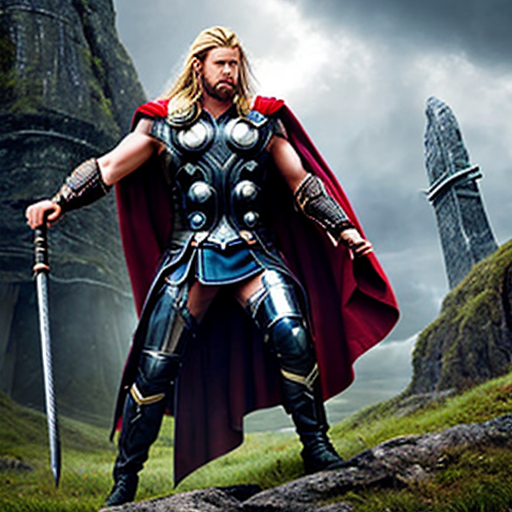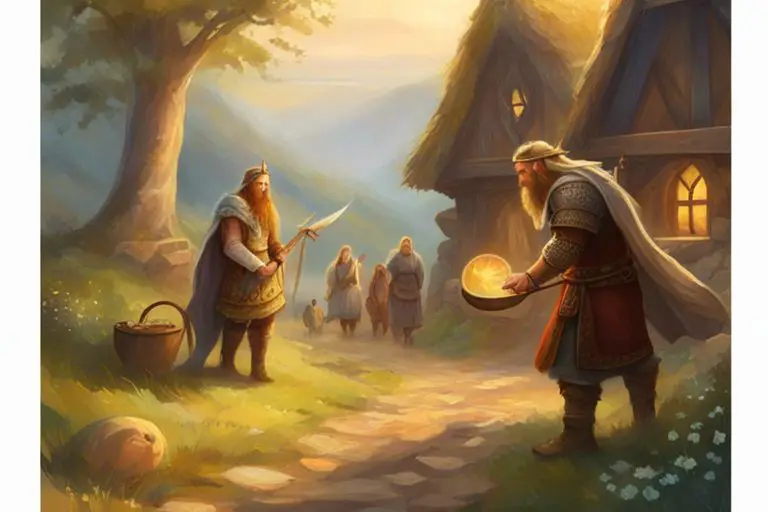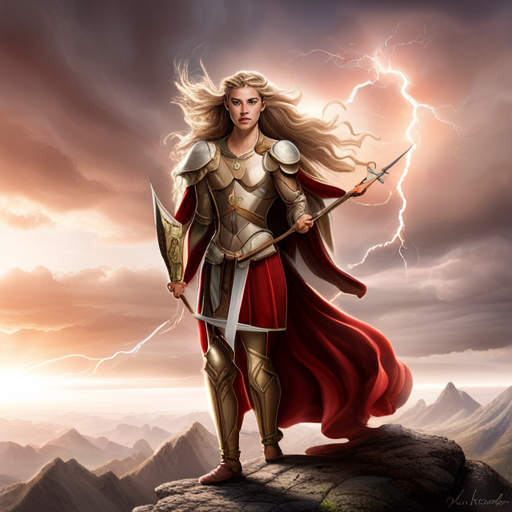As a fan of Norse mythology, I have always been fascinated by the character of Thor. Known for his incredible strength, courage, and loyalty, Thor has captured the hearts of countless people around the world.
However, there has long been a debate among scholars and fans alike over Thor’s origins. Specifically, there is a question whether Thor is half-giant or not. This mystery has intrigued me for years, and I decided to finally dive into the evidence and debunk the mystery once and for all.
To me, the mystery of Thor’s half-giant heritage is more than just an academic debate. It is a symbol for the importance of understanding our own origins and heritage. As humans, we all have a subconscious desire for belonging, for knowing where we came from and who we are.
In a sense, the mystery of Thor’s origins is a reflection of our own search for identity. By exploring the evidence and arguments for and against Thor’s half-giant heritage, we can gain a deeper understanding of not only his character but also ourselves.
The Debate over Thor’s Origins
Now, you’re probably wondering where all of this debate over Thor’s origins is coming from.
Well, let’s take a closer look at the arguments and theories being presented.
Some scholars argue that Thor is a half-giant, while others believe he is a full-blooded god.
The debate stems from the fact that Thor’s mother, Jord, is a giantess, while his father, Odin, is a god.
Some argue that this makes Thor a half-giant, while others claim that his godly heritage takes precedence over his mother’s giant blood.
The argument for Thor being a half-giant comes from his physical appearance and powers.
Thor is known for his incredible strength, which some believe comes from his giant heritage.
He is also depicted as having red hair and a beard, which some scholars argue is a trait of giants in Norse mythology.
However, there is no concrete evidence to support this theory, and some argue that Thor’s godly powers and status as one of the Aesir gods outweigh any influence from his mother’s giant blood.
So, the debate over Thor’s origins continues to rage on.
Evidence for Thor’s Half-Giant Heritage
The evidence presented suggests that Thor’s lineage may be more complex than previously thought, with some sources pointing to his mother being of giant descent. This is further supported by the fact that many gods in Norse mythology had giant ancestors.
In the Prose Edda, it is mentioned that Thor’s mother, Jörð, was a giantess, while his father, Odin, was a god. Additionally, Thor is often depicted as being much larger than other gods, which could also be an indication of his half-giant heritage.
This theory is further supported by the fact that giants and gods often intermarried in Norse mythology, making it plausible that Thor himself may have inherited some giant traits. While some may argue that Thor’s size and strength can be attributed solely to his godly heritage, it is important to consider the cultural context in which these stories were created.
In Norse mythology, giants were often portrayed as being powerful and formidable adversaries of the gods. By giving Thor a half-giant heritage, it would have made him even more impressive and formidable to the people who worshipped him. However, as with any historical or mythical theory, there are always counterarguments to consider.
Counterarguments to the Half-Giant Theory
You might be surprised to learn that there are counterarguments to the theory that Thor is half-giant. Although some sources suggest that his mother may have been a giantess, others argue that this is merely speculation.
In fact, many scholars believe that Thor’s size and strength were simply a result of his godly heritage. As a god of thunder and lightning, Thor was imbued with incredible power, which he used to protect the realm of the gods from the forces of chaos and destruction.
Furthermore, some skeptics argue that the idea of Thor being half-giant is a modern invention, created to make the character more relatable to modern audiences. They point out that the concept of giants and gods interbreeding is not well-supported in Norse mythology, and that there are few references to it in the original texts.
Instead, they suggest that Thor’s status as a god of thunder and lightning was enough to make him a formidable and awe-inspiring figure in the minds of the ancient Norse people.
Now that we’ve explored the counterarguments to the half-giant theory, let’s take a closer look at Thor’s role in Norse mythology.

Thor’s Role in Norse Mythology
Let’s dive into what role this powerful deity played in the ancient stories and legends of his people.
In Norse mythology, Thor was the god of thunder and one of the most important deities in the pantheon. He was renowned for his immense strength and bravery, and was often depicted wielding his mighty hammer, Mjolnir, which was said to be capable of leveling mountains and smashing entire armies.
Thor was also associated with fertility and protection, and was believed to be a champion of the common people, particularly farmers and fishermen.
Throughout the myths and legends of Norse mythology, Thor played a central role in many of the most important stories. He was often called upon to defend the realm of the gods from the machinations of their enemies, including giants, trolls, and other malevolent creatures.
Thor was also a frequent traveler, venturing to distant lands and encountering all manner of strange and wondrous beings. Despite his fearsome reputation, Thor was also known for his sense of humor and his love of feasting and revelry.
All of these elements contributed to making Thor one of the most beloved and enduring figures in Norse mythology.
From here, we’ll explore the significance of the half-giant debate, and why it’s sparked such interest and speculation among scholars and enthusiasts of Norse mythology.
The Significance of the Half-Giant Debate
Exploring the debate surrounding Thor’s heritage has sparked intense curiosity and fascination among scholars and fans alike.
Many people have been debating whether he is a half-giant or not, and this has caused a lot of confusion. Some people believe that he is a half-giant because of his immense strength and size, while others argue that he is not because there is no evidence to support this claim.
The significance of this debate lies in the fact that it affects our understanding of Norse mythology. If Thor is a half-giant, then it means that there is a connection between the gods and the giants, and this would change the way we view the relationship between these two groups.
If he is not, then it means that the gods are distinct from the giants, and this would confirm the traditional view of Norse mythology.
In any case, the mystery surrounding Thor’s heritage is one that continues to captivate us and inspire us to delve deeper into the rich and complex world of Norse mythology.
Frequently Asked Questions
What is the origin of the name “Thor” in Norse mythology?
As I delved deeper into Norse mythology, I couldn’t help but wonder about the origin of the name Thor. It’s a name that evokes power and strength, like the sound of thunder in the distance.
And as I searched for answers, I discovered that Thor’s name actually means ‘thunder’ in Old Norse. It’s fitting, considering that Thor was the god of thunder, wielding his mighty hammer Mjolnir to summon thunderstorms and protect the realm of the gods.
It’s fascinating to think about how a simple name can hold so much meaning and symbolism in a mythology that has captivated people for centuries.
Is there any evidence to suggest that Thor was actually a human who became a god?
To answer the question of whether there’s evidence to suggest that Thor was actually a human who became a god, we must turn to the stories and myths of Norse mythology.
While there are many tales of Thor’s exploits and adventures, there’s no clear indication that he was once a mortal man. Instead, he’s consistently portrayed as a powerful deity, with control over thunder and lightning, and a champion of the gods against their enemies.
While there may be some variations in the stories, the overall portrayal of Thor as a god remains consistent, and there’s no reason to believe that he was anything other than divine.
What is the significance of Thor’s hammer, Mjolnir, in Norse mythology?
The significance of Thor’s hammer, Mjolnir, in Norse mythology cannot be overstated. As the god of thunder and lightning, Thor wielded Mjolnir as a symbol of his power and authority.
The hammer was also believed to have the power to control the weather and protect against evil forces. Mjolnir was not just a weapon but a symbol of Thor’s divine status and his ability to protect his people.
The hammer was so important that it was even used in marriage ceremonies, symbolizing the union of two people under the protection of Thor. Mjolnir remains one of the most iconic symbols of Norse mythology and a symbol of strength and protection for many today.
Did Thor have any siblings or family members who were also gods or giants?
Thor, the powerful god of thunder in Norse mythology, had many siblings and family members who were also gods and giants.
His father was Odin, the king of the gods, and his mother was Jord, the goddess of the earth. He had a stepmother named Frigg, who was also a goddess.
Thor’s siblings included Balder, the god of light and purity, and Hod, the god of darkness and winter. He also had a half-brother named Loki, who was both a god and a giant.
With such a diverse and complex family, it’s no wonder that Thor was such a dynamic and multifaceted character in Norse mythology.
How did Thor become associated with thunder and lightning in Norse mythology?
When it comes to Norse mythology, one can’t talk about Thor without mentioning his association with thunder and lightning.
The reason for this is simple: Thor was believed to be the god of thunder and lightning.
According to Norse mythology, Thor was known to wield a powerful hammer called Mjölnir, which he used to create thunder and lightning bolts.
The sound of the thunder was believed to be the result of Thor’s hammer striking the clouds, and the lightning bolts were the result of the sparks that flew from the hammer.
Thor was also believed to be the protector of mankind, and it was said that he would use his powers to defend them from harm.
It’s no wonder that Thor was one of the most popular gods in Norse mythology.
Conclusion
In conclusion, the mystery surrounding Thor’s half-giant heritage in Norse mythology has been a topic of debate for centuries. While some scholars argue that Thor’s physical strength and size suggest a half-giant origin, others point to his familial relations with the gods and goddesses as evidence of his full divine heritage.
Ultimately, there is no definitive answer to this debate. However, regardless of his origins, Thor remains one of the most beloved and iconic figures in Norse mythology. His tales of heroism and bravery continue to inspire people to this day, reminding us of the power of strength, courage, and determination in the face of adversity.
As the saying goes, ‘What doesn’t kill you makes you stronger,’ and for Thor, this couldn’t be more true.





